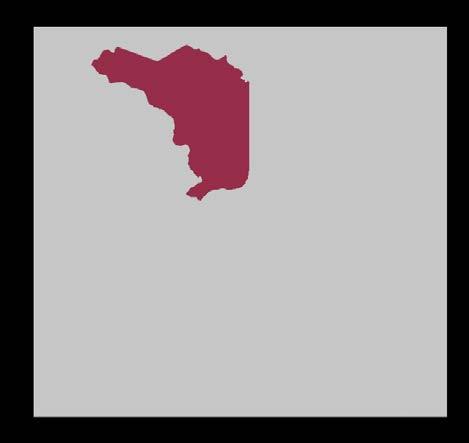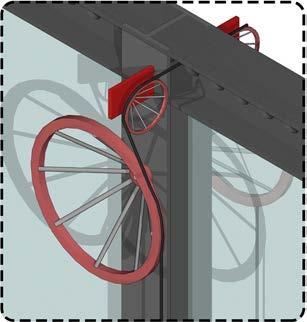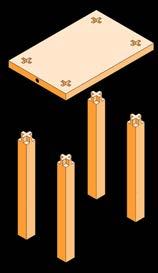

CONCEPTS
SELECTED
PROJECTS
2017-2024
Antonio Fernández Vargas

01
URBAN MUTATIONS
GRADUATION PROJECT HONORS THESIS
PROF. CARLOS UMAÑA & WALTER LEONE
2020 | ALAJUELA
48´000m²
BRIEF
SCALE: XL
More than 25% of shopping malls were to close in the United States by 2022. In Costa Rica, the massive closure of malls began in the 2010s (a delay compared to the United States, where the phenomenon began in the 1990s). There are more than 1’400’000m2 of shopping malls in the Great Metropolitan Area (Costa Rica), so it is urgent to find alternative uses for them before they become empty. Since the mall is defined as an enclosed, private, guarded, exclusive and impermeable space, the questions arise: can a space designed for a particular use become its own antithesis? To carry out the project and answer this question, we studied the International Mall of Alajuela, a building that once housed the most important commercial space in the province and can now described as a postmodern ruin.

Province: Alajuela

District: Alajuela

The dividing walls: Inspired in Rem Koolhaas’ Exodus, the mall is located in a strip of land- completely segregating it from its context with a series of introverted spaces.
1. Mall Internacional 2. City Mall 3. San Rafael Hospital 4. Outlet Store
5. Milling Plant 6. National Technical University (UTN) 7. Supermarket 8. Outlet Store
These ruins have contaminated the context in such a way that it can be categorized as Terrain Vague (de Solá Morales), therefore the damaged fabric must be regenerated. This property activated the lot in the main entrance to the city since 1993, and was completely displaced by the arrival of the City Mall in 2017 -at just 50m away. Being left as a ghost mall, the project seeks to turn it into its antithesis, and make it an urban generator capable of maximizing relationships with its context and making it an urban actor.
To achieve this, I first had to define the mall through its program and the spacial features it had. closed private guarded exclusive impermeable
Then I defined what its anthisesis meant. open public free inclusive permeable
Consequently it was decided to eliminate some parts of the building that gave it introverted characteristics and deprived it of its surroundings.
By operating directly on the building and regenerating parts of the surroundings, it was possible to open it up to the public realm.
To make these changes to the site, Rem Koolhaas’ design theories were studied, such as the free section and the programmatic strips of the Parc de la Villette.
By applying these theories, a programmatic instability is generated that facilitates urban accidents. This allows spontaneous activities to occur without being completely manipulated by the architect, thus allowing the building to respond to urban needs and the times of the city. All this is facilitated through mechanisms that allow it to mutate over time.

Urban fabric generation scheme



Built section is eliminated and opened up to the neighborhood, using the existing level difference to create public space.

Current mall: ravine in poor condition to the north surrounded by abandoned lots and houses in poor condition. 03. The modules are offset to create shadows with the eaves. The flows of the city towards the public spaces are traced.
Cross Section



Passive techniques are used to allow natural lighting and ventilation. The auditorium receives the flows coming from Alajuela with green areas.


Handrail details


Seating detail

Ramp arrival and connection with walkway


Isometric: Operation of pulleys and details
Metalum galvanized iron roo ng sheet with rectangular pro le calibre .26
Wooden parasol with 6”x24”x2” slats
Tempered glass (6mm width) Vilax Deep Red
Black structural iron nailers 2 x 3 "
OSB wooden board with acoustic insulation
Concrete slab 210kg/cm3 with polished nishing
25x12cm gutter, stainless aluminum
Steel joists 4”x3” @ 60cm
Angular 12 "x12" Steel 4mm calibre
IPN 180 beam with boreholes in the neutral axis for cable feed-throughs
Movable panel w/ steel cable anchor for 1" pulley
Klein frameless commercial sliding door



D01
D02
D01: Gutter detail
D02: Pulley detail


Topography unevenness, and free section along service bands and urban space.
Access and roofed plaza



02
MARYLAND HOTEL
UNIT XI
PROF. ADRIÁN AGUILAR & LAURA SOTO
2019
| SAN JOSÉ 2200m²
BRIEF
SCALE: M
The project consisted in readapting the Maryland Building (an art deco building from 1937 designed by Costa Rican architect -Chisco Salazar) to create a hotel. The design challenge was to interpret Escher’s work in an urban context while adapting it to a hotel chain’s needs. To relate it to the artist, the stairs were the hierarchical element in the interior spaces. The metamorphosis of the artist was also interpreted along the facade with a slow rhythm of volumes coming in and out. The design features environments where the penumbra plays a key role in its interiors, as well as dichotomies such as light-dark and full and empty. In order to respect the original building, the new addition steps back 1 meter on the third level to show the change of temporality and the architectural richness that the building already provides.

Province: San José

District: San José


Step 1: Original Building




Step 5: Staggered effect
Step 2: Vertical Circulation + 1st Block
Step 3: 2nd Block
Step 4: 3rd Block



HOTEL NIMBU
UNIT X
PROF. JOSÉ VARGAS & DANA VÍQUEZ
2019 | GUANACASTE
3´400m²
BRIEF
SCALE: M
The project consists of a hotel located in Playas del Coco, where there is a mangrove that few locals know about. The mangrove was kept as a very important axis throughout the project because it is a very difficult ecosystem to regenerate and is unique in its kind for its various biological functions. The concept of the project was the window, so the axes in the distribution were extremely important. The main space is the lobby, which consists of a triple height that serves to frame the views of the mangrove swamp and the beach, which is located in front of the hotel. To enhance the feeling of “being in the mangrove”, corridors were designed at water level leading to the rooms.

Province: Guanacaste

District: Carrillo




L1 - Restaurant, admin, rooms
GF - Lobby, reception, pool, bar, rooms
L2 - Spa, rooms
View from beach towards main facade
Isometric - Hotel Components by Block
Facade concept - The big roof covering the room volumes
Beach - restaurant public space connector


View from 2nd floor corridors facing rooms and mangrove
View from mangrove towards beach




“Listen or your tongue will make you deaf”
04
RESILIENT CAÑAS
UNIT IX
PROF. WALTER LEONE & ALEJANDRO VALLEJO
2018 | GUANACASTE
50m²
BRIEF
SCALE: S
Resilient Cañas seeks to rediscover the identity of Río Cañas, a community which has been threatened by the emigration of inhabitants due to the floodings caused by the river. Multiple workshops were carried out with the community for them to become part of the design process.
The project sought to design a glocal architecture (global and local), thus responding to the context without invading it: rescuing traditions such as the palo encebado, roof thatching and facilitating program shifts. The use of local materials was indispensable since the idea was for the community to build and take responsibility of the project.
In terms of flexibility, sunshades were generated with the legs and tabletops that could then be assembled in a simple manner. The panels can be rotated and allow the outside to mix with the inside to strengthen this relationship at different levels.

Province: Guanacaste

District: Santa Cruz




Process sketches (from left to right): 1) study of Latin American references for a communal space, 2) study of local building archetypes and constructive techniques in Río Cañas, 3) study of materiality, enclosures and modulation.

Section Cut - Scenario 1 (Free interior space)
Ideation process and brainstorming with the whole community
Ideation process with the youth of the community





Section Cut - Scenario 2 (Classroom inside)
Image of one of the final built projects (Proposal by Carolina Moraga)
Team-building activities with the community



Table assemblage
Exploded isometric with material count



Table leg assembly in enclosure: Step 1
Table leg assembly in enclosure: Step 2 -ZoomIn
Table leg assembly in enclosure: Step 3


ANNEXES
56 HOURS - DOCEXDOCE COMPETITION Special edition for “Amigos Solidarios-Honduras” - 2020
The goal for this 56-hour competition was to think of new ways to reuse the fuselage of abandoned aircrafts. The competition’s requirements were an image and a text explaining each teams searches. In our case, we explored how these objects could maintain their purpose as a structure capable of transporting migrants through international borders. I was in charge of most parts of the image and part of the text.
The aircraft no longer flies.
How do we preserve its capacity to transport if it remains static?
The democratization of its parts is proposed in order to maintain its character as a mediator between nations separated by imaginary limits. These spaces question the border, promoting migratory flows through walls conceived to be inaccessible.

Illustration and text for “56 hours” First place with team member Jorge Barzuna 2020 - docexdoce Competition
A LANDMARK FOR BARRIO ESCALANTE
Edilex Facade Competition - 2019



This competition consisted in the design of a facade for a Communications and Marketing Office in San Jose, Costa Rica. It’s located in a neighborhood known for its modern brick houses: thus the selection of this noble material for a contemporary application. The team also decided to use a sliding corten steel panel for the access as it matches the color palette as well as the intentions of using pure, well-aging materials. For this competition, I was part of the design process, rendering views, and drawing construction plans.
Conceptual collage, facade illustration and facade diagram for “Concurso Edilex” First place with team members Alejandra Fernández and Daniela Rumoroso 2019 - Universidad Veritas Competition
RCR Summer Workshop 2020
This workshop ‘s objective was to create a “space of comprehension” where Catalan chef Ferrán Adriá’s book “Sapiens” would be displayed. After a series of interpretations of the site and multi technique experimentations, inspired by various artists, the group I was part of (with Gianfranco Morales from Peru and Soledad Larraín from Chile) decided to merge architecture with landscape, thus creating a sequence of introspective spaces where the user would be prepared to access the final space of revelation where the book would be kept.

Interpretation of the macro site “The topography of the fog” (Olot)

The entrance to the built space.
A very valuable aspect of this workshop was to learn and put to practice the design methodology of RCR, which requires a very thoughtful process and sensible critical thinking in order to create an architecture that can be easily read as belonging to the site.



Mondo Nostrum Magazine 2020
MANIFESTO
MONDO NOSTRUM is a document focused on the analysis and communication of poetic-philosophical -theoretical and critical thinking, and relevant and pertinent ideas and designs in architecture, urbanism, ruralism (and other areas of design) throughout the planet.
MONDO NOSTRUM acts as an agent of change to “promote sustainability, social justice and beauty in the built environment - architecture, cities and human settlements - throughout the Planet, by publishing ideas and advanced solutions for environmental design and construction.
MONDO NOSTRUM is made up of experts, activists, intellectuals and professionals from different disciplines from all over the planet.
*(Nomad School for Planetary Design)
Editorial staff: Mauricio Quirós, Fredy Masad and Luis Alberto Monge
Coordinator: Sharon Salas
Edition and translation: Antonio Fernández, Alejandra Fernández, Martina Massad and Marta Fúster.
Design and production: Rocío L. Berenguer and Nicolás M. Rueda

Translation and edition of Peter Stutchbury’s article by Antonio Fernández. Translation and edition of Jiat-Hwee Chang’s interview by Antonio Fernández.
Director: Álvaro Rojas
UNIT 5
Elements of Dwelling - 2020

UNIT 8
For this Unit, students were asked to read Martin Heidegger’s passage “Building Dwelling Thinking” and conceptualize their findings into a three-dimensional plaster model. For this, space was firstly thought of as a solid, and throughout the process of site interpretation, it acquired spatial features. Another important reference for this Unit was Spanish sculptor, Jorge de Oteiza -due to the capacity of his sculptures to engage with the inmediate context while creating open, inhabitable spaces.

Repurposing La Galera - 2021


This Unit consisted in the design of an elevated passway for pedestrians over a very traveled road in the east of San José. For this, the thirdyear students had to interpret the site and come up with a concept that would guide their design. Students were encouraged to create a series of spaces for the multiple user profiles from the community- engaging with them with a series of experiences that would offer safe, aesthetic and functional conditions.

Photoshop Workshop directed by me to help students with their presentation skills.
Exploded isometric by David Zúñiga.
Luisa Salgado Presentation
Jaylean Henry Concept Board
UNDISCLOSED
GENSLER PROJECT #1 2021-2022

Project #1: Non-disclosed location. Urban design. Property of Gensler©

Project #1: Non-disclosed location. Interior space. Property of Gensler©

Project #1: Non-disclosed location. Exterior space over the former road. Property of Gensler©
This project was located next to one of the most important parks in the city. The mixed use project consisted in a theatre, a cinema 4 towers (of which 2 were residential and 2 were for corporate) and a hotel. One of the main intentions was to substitute a street by creating an open public space, along with other key features that improved the lifestyle of the citizens through enriching experiences of high quality design. My responsibilities were mainly 3D modelling, including facades of high rise corporate towers, a cinema, a parking building and storefront design. I also collaborated with the presentations for the clients as well as process renderings. Here I learned about the importance of caring for the clients’ interests, making the most of the available resources- which are also limited in projects of these scales.
UNDISCLOSED GENSLER PROJECT #2 2022-2023

Project #2: Non-disclosed location. Mall access park. Property of Gensler©

Project #2: Non-disclosed location. Interior mall feature. Property of Gensler©
The project consisted in the expansion of an existing luxurious mall, where the client wanted to have a key feature that created an anchor point for the visitors to walk around and create more dynamic flows along the interiors. The program of the expansion included a food court, a food hall and a bowling alley -among commercial stores. The team, along with the client, decided to use a set of local materials in order to create a local architecture.
My main responsibilities were creating presentations for the clients and the 3D modelling of the new construction, which included the design process of the main feature, a food hall and a food court. In this project I learned about team managing and client relationship, which has been very valuable for my career.
